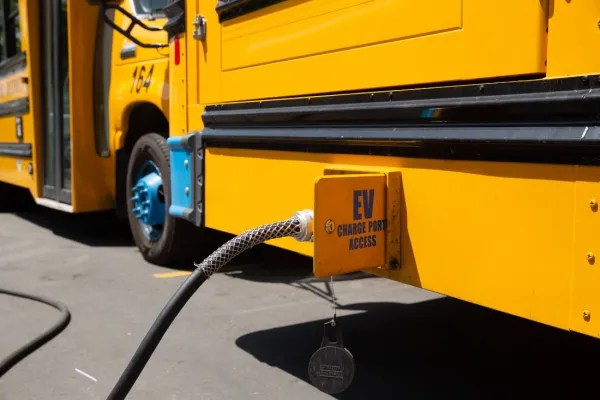For all of the mobility they offer, cars, in general, spend most of their time sitting still. The average American spends around an hour a day driving, according to AAA, and in a country with roughly one vehicle per person, that’s a lot of cars just sitting around doing nothing.
Electric vehicles create an opportunity to put that downtime to use. While EVs can already serve as a backup battery for homes, engineers have long been pursuing technology to tie all of those batteries to the grid, serving as a massive virtual power plant to help manage fluctuations in electricity production and demand.
This fall, Oakland, California’s school district is making that vision a reality.

The district recently announced it is replacing all of its diesel buses with electric ones equipped with vehicle-to-grid (V2G) technology that will allow the buses to serve as a resource for utility Pacific Gas & Electric.
As Matt Simon of Wired explains, the buses provide an ideal platform. They operate on a predictable schedule, can charge during the day when solar power peaks and at night when demand is low, and are usually sitting idle during the evening, when solar generation plummets and the need for stored energy is highest.
For school districts, that also provides a new source of revenue, helping to offset the much higher cost of the buses.
So what about those millions of cars? That’s a little more complicated.
Willett Kempton, a University of Delaware professor, has been working on that problem for decades. While the concept is simple, a vast array of vehicles, charging configurations, and usage times can create a lot of uncertainty for utilities.
“When something’s pushing power onto the grid, they want to know what that is,” Kempton told Canary Media in February. “They don’t want to be like, ‘We’re 95 percent sure which car it is.’”
Kempton reached a significant breakthrough this year in developing a V2G standard that was recently adopted by SAE International, which provides guidance on universal standards for automakers on everything from tires to oil viscosity.
Major car companies are now rushing to produce models with V2G capability.
“This is a real thing,” an executive from a British V2G company told Reuters. “It’s no longer a theoretical, academic discussion.”
More clean energy news
🚗 Speaking of electric vehicles: The Biden administration last week announced a 100% tariff on Chinese EVs, which some critics say could jeopardize climate goals; an editorial board says U.S. automakers have only themselves to blame for not being globally competitive. (E&E News, Los Angeles Times)
🔧 When getting there isn’t half the fun: As the Biden administration offers billions to ramp up hydrogen production, the fuel is dangerous and costly to transport and there are no clear rules for pipeline siting. (E&E News)
☀️ Solar’s staggering growth: The U.S. has surpassed 5 million solar installations, with more than half of those coming online since 2020, according to a new industry report. (Power Magazine)
🏭 Rust belt revival: Midwest states have received nearly $30 billion in private investments to boost clean energy manufacturing since Congress passed the Inflation Reduction Act in late 2022. (Inside Climate News)
👷 Green jobs: Community colleges around the country are offering training programs in clean energy technology, in response to a surge in job demand since the passage of federal climate legislation. (Associated Press)
🛢️ Questionable commitments: In separate reports, advocacy groups this week have called efforts to decarbonize air travel a “huge greenwashing exercise,” and said “there is no evidence that big oil and gas companies are acting seriously to be part of the energy transition.” (The Guardian)
⚖️ Energy justice: Advocates say Minnesota regulators should reinstate a moratorium on utility shutoffs after researchers found racial disparities in disconnections by Xcel Energy, even after accounting for income and other factors. (Energy News Network)
📢 We want to hear from you! Send us your questions, comments, and story tips by replying to this email.
💸 Support our work: The Energy News Network is powered by support from readers like you. If you like Energy News Weekly, share it with a friend! Or give today and help us keep our news open and accessible for all.
📧 Want more energy news? Sign up for our daily digests.
